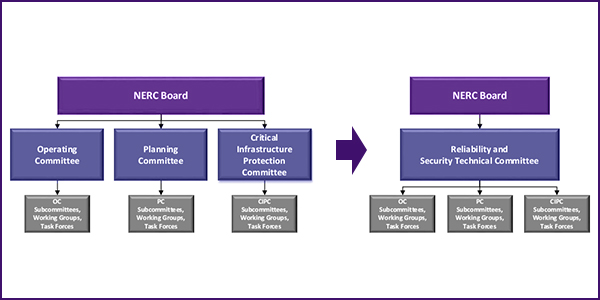By Holden Mann
ATLANTA — It’s musical chairs for those seeking to join NERC’s new Reliability and Security Technical Committee (RSTC), with 35 stakeholders vying for 14 seats in seven sectors.
The 34-member RSTC next year will take over the duties of the Planning, Operating and Critical Infrastructure Protection committees, which have more than 120 members combined. (See NERC Board OKs Committees Merger.)
At a joint meeting of the three committees this week in Atlanta, MISO’s David Zwergel, who will be vice chair of the new group, told members that NERC has completed the sector nomination period, the first stage of the membership selection.

| NERC
Two representatives each were sought from sectors 1-10 and 12, but all but four of the sectors submitted more than two nominees; they are holding elections through Dec. 20 to narrow it down to two. Sectors 1 (investor-owned utilities) and 9 (small end-use electricity customers) each have seven candidates. Sectors 4 (federal or provincial utilities/power marketing administrations) and 8 (large end-use electricity customers) have five candidates each.
The remaining sectors did not require elections, so their representatives will take their seats at the RSTC’s first meeting in March:
- Sector 3 (cooperatives): Ben Engelby of Arizona Generation and Transmission Cooperatives, and Marc Child of Great River Energy;
- Sector 5 (transmission-dependent utilities): John Stephens of City Utilities of Springfield, and Carl Turner of Florida Municipal Power Agency;
- Sector 10 (ISOs/RTOs): Christine Hasha of ERCOT, and Wesley Yeomans of NYISO; and
- Sector 12 (state governments): Christine Ericson of the Illinois Commerce Commission, and Cezar Panait of the Minnesota Public Utilities Commission.
At-large Nominations Begin this Month

The remaining 10 seats on the new committee will be filled by at-large members to be chosen on Feb. 6 by its Nominating Subcommittee, initially composed of Zwergel and Chair Greg Ford; NERC Chair Roy Thilly; CEO Jim Robb; and Member Representatives Committee Vice Chair Jennifer Sterling. Nominations for at-large members will open Dec. 30 and close on Jan. 10, with the resulting candidates judged based on how they reinforce and complement sector appointees’ strengths.
“If you were nominated [as] a sector rep and weren’t selected … through the election, you’re not automatically put in the at-large, but you can nominate yourself again,” Zwergel said. “The [factors] to be considered [are] interconnection diversity, Canadian representation, broad spectrum of [entity] sector and size, and then expertise.”
Beginning with the first RSTC meeting in June, half of the initial member slate will serve two-year terms, while the rest will serve for three years; following the initial terms, future members will serve for two years, to expire in June of alternating years.
Communication Plan Suggested
Members of the three retiring committees raised no major objections to the existing transition plan. However, Peter Brandien of ISO-NE suggested that NERC consider the impact of the smaller RSTC membership, particularly regarding communicating the committee’s decisions to the broader industry.
“It is going to be a much smaller group, so you’re losing the benefit of providing the information to a large audience that … can then take [it] back to their home office [and] distribute [it],” Brandien said. “So, I think the committee has to think about how to get that information out to industry a bit more.”
While the RSTC is set up, the OC, PC and CIPC will continue to meet according to their current schedules. The RSTC will hold its first meeting March 4 to elect the executive committee and hold its initial regular meeting in June to coincide with the final meetings of the retiring committees.



